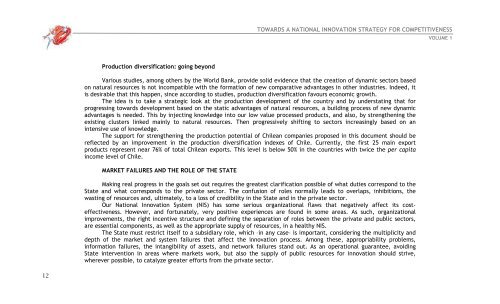Libro Blanco Vol I en Ingles
Libro Blanco Vol I en Ingles
Libro Blanco Vol I en Ingles
You also want an ePaper? Increase the reach of your titles
YUMPU automatically turns print PDFs into web optimized ePapers that Google loves.
TOWARDS A NATIONAL INNOVATION STRATEGY FOR COMPETITIVENESSVOLUME 1Production diversification: going beyondVarious studies, among others by the World Bank, provide solid evid<strong>en</strong>ce that the creation of dynamic sectors basedon natural resources is not incompatible with the formation of new comparative advantages in other industries. Indeed, itis desirable that this happ<strong>en</strong>, since according to studies, production diversification favours economic growth.The idea is to take a strategic look at the production developm<strong>en</strong>t of the country and by understating that forprogressing towards developm<strong>en</strong>t based on the static advantages of natural resources, a building process of new dynamicadvantages is needed. This by injecting knowledge into our low value processed products, and also, by str<strong>en</strong>gth<strong>en</strong>ing theexisting clusters linked mainly to natural resources. Th<strong>en</strong> progressively shifting to sectors increasingly based on anint<strong>en</strong>sive use of knowledge.The support for str<strong>en</strong>gth<strong>en</strong>ing the production pot<strong>en</strong>tial of Chilean companies proposed in this docum<strong>en</strong>t should bereflected by an improvem<strong>en</strong>t in the production diversification indexes of Chile. Curr<strong>en</strong>tly, the first 25 main exportproducts repres<strong>en</strong>t near 76% of total Chilean exports. This level is below 50% in the countries with twice the per capitaincome level of Chile.MARKET FAILURES AND THE ROLE OF THE STATEMaking real progress in the goals set out requires the greatest clarification possible of what duties correspond to theState and what corresponds to the private sector. The confusion of roles normally leads to overlaps, inhibitions, thewasting of resources and, ultimately, to a loss of credibility in the State and in the private sector.Our National Innovation System (NIS) has some serious organizational flaws that negatively affect its costeffectiv<strong>en</strong>ess.However, and fortunately, very positive experi<strong>en</strong>ces are found in some areas. As such, organizationalimprovem<strong>en</strong>ts, the right inc<strong>en</strong>tive structure and defining the separation of roles betwe<strong>en</strong> the private and public sectors,are ess<strong>en</strong>tial compon<strong>en</strong>ts, as well as the appropriate supply of resources, in a healthy NIS.The State must restrict itself to a subsidiary role, which –in any case– is important, considering the multiplicity anddepth of the market and system failures that affect the innovation process. Among these, appropriability problems,information failures, the intangibility of assets, and network failures stand out. As an operational guarantee, avoidingState interv<strong>en</strong>tion in areas where markets work, but also the supply of public resources for innovation should strive,wherever possible, to catalyze greater efforts from the private sector.12












![[Tam] Uygula[ya] - Bilim, Teknoloji ve Ä°novasyon Politikaları TartıÅma ...](https://img.yumpu.com/36820041/1/184x260/tam-uygulaya-bilim-teknoloji-ve-anovasyon-politikalara-tartaama-.jpg?quality=85)



